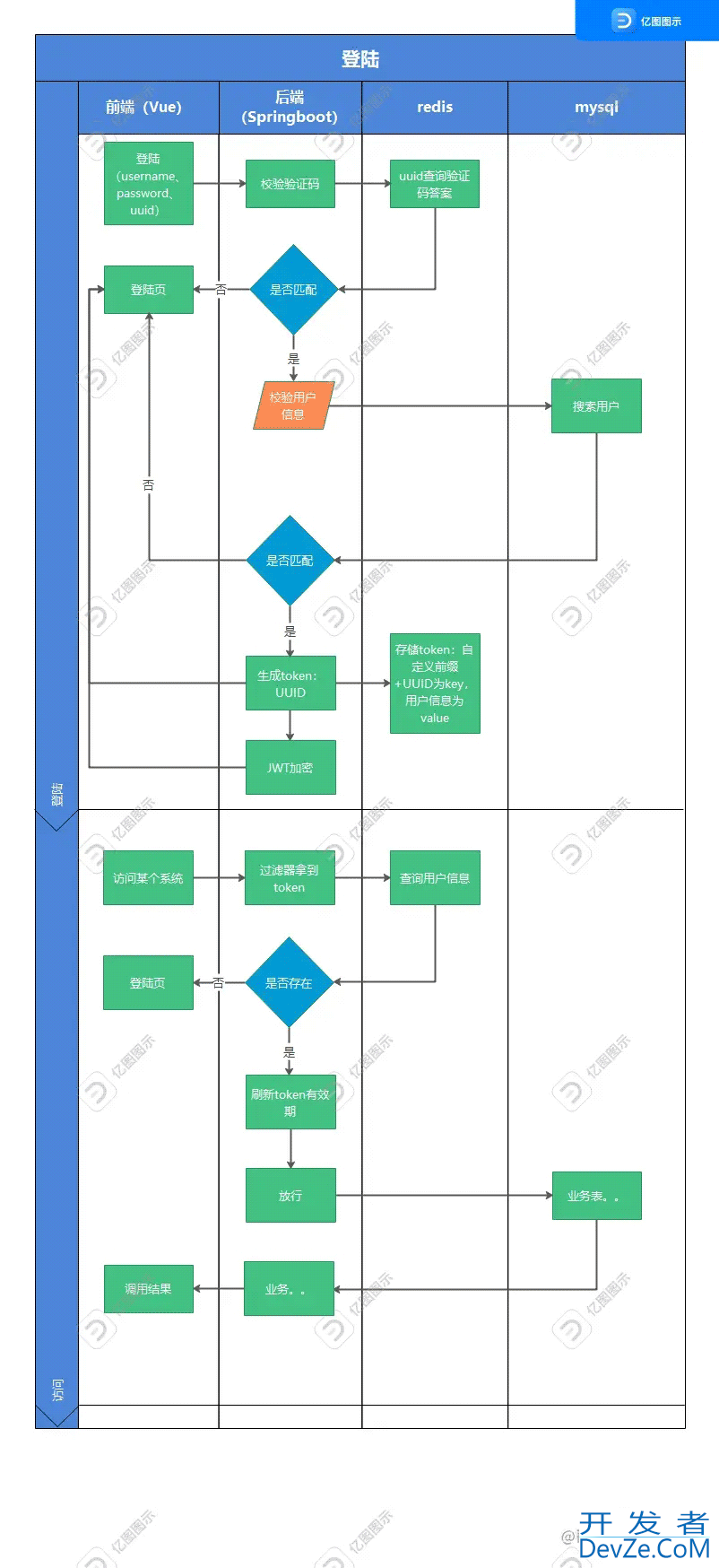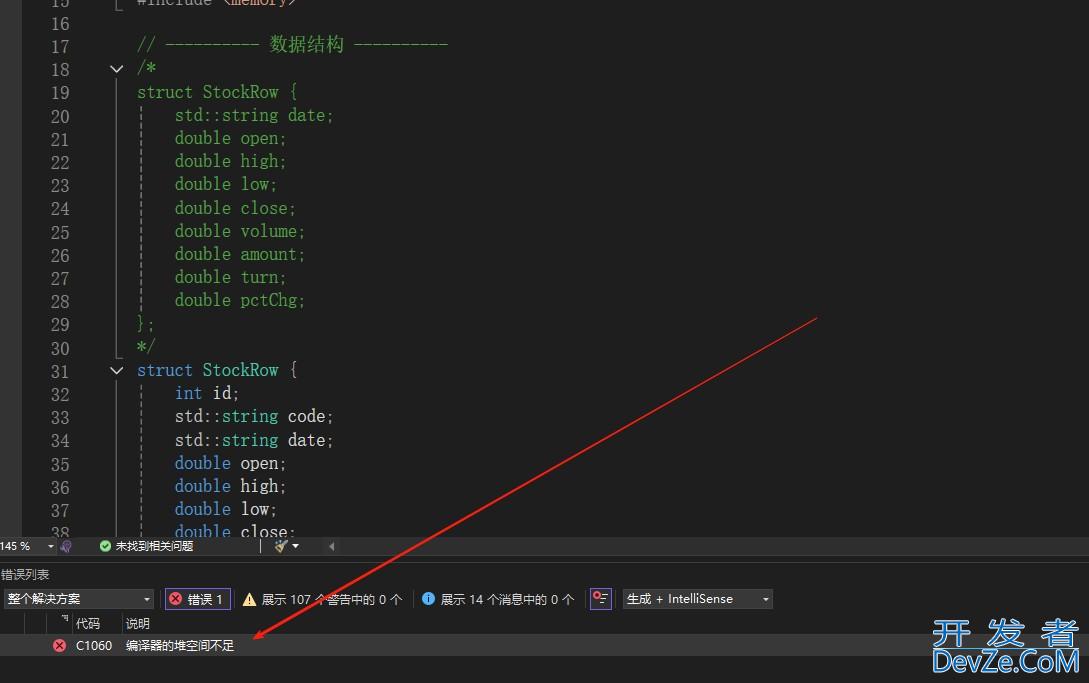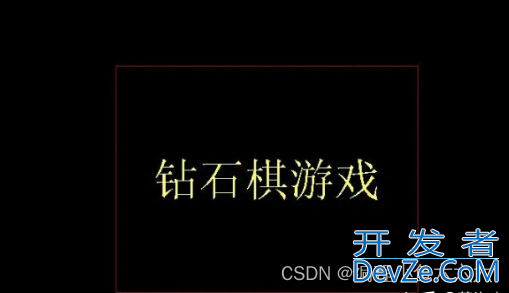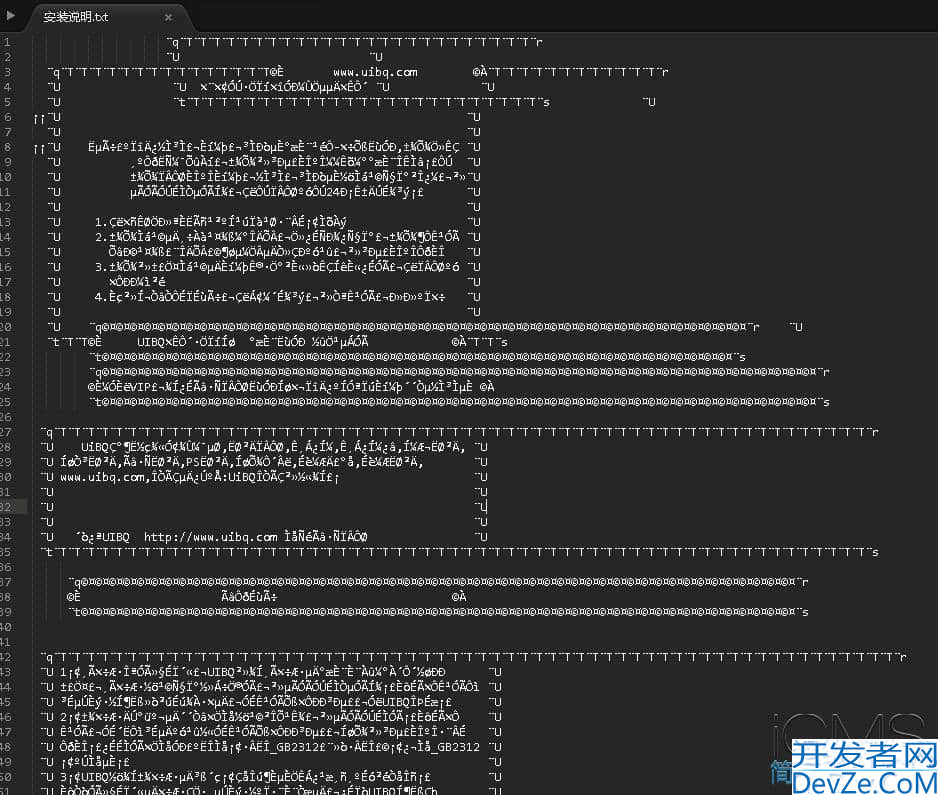Springboot Vue实现单点登陆功能示例详解
目录
- 正文
- 简单上个图
- 先分析下登陆要做啥
- 怎么落实?
- 上代码
- 接口:
- token生成部分
- 刷新token
- 验证token
正文
登陆是系统最基础的功能之一。这么长时间了,一直在写业务,这个基础功能反而没怎么好好研究,都忘差不多了。今天没事儿就来撸一下。
以目前在接触和学习的一个开源系统为例,来分析一下登陆该怎么做。代码的话我就直接CV了。
简单上个图
(有水印。因为穷所以没开会员)

先分析下登陆要做啥
首先,搞清楚要做什么。
登陆了,系统就知道这是谁,他有什么权限,可以给他开放些什么业务功能,他能看到些什么菜单?。。。这是这个功能的目的和存在的意义。
怎么落实?
怎么实现它?用什么实现?
我们的项目是Springboot + vue前后端分离类型的。
选择用token + Redis 实现,权限的话用SpringSecurity来做。
前后端分离避不开的一个问题就是单点登陆,单点登陆咱们有很多实现方式:CAS中央认证、JWT、token等,咱们这种方式其实本身就是基于tok开发者_Js入门en的一个单点登陆的实现方案。
单点登陆我们改天整理一篇OAuth2.0的实现方式,今天不搞这个。
上代码
概念这个东西越说越玄。咱们直接上代码吧。
接口:
@PostMapping("/login")
public AJAXResult login(@RequestBody LoginBodyphp loginBody)
{
AjaxResult ajax = AjaxResult.success();
// 生成令牌
//用户名、密码、验证码、uuid
String token = loginService.login(loginBody.getUsername(), loginBody.getPassword(), loginBody.getCode(),
loginBody.getUuid());
ajax.put(Constants.TOKEN, token);
return ajax;
}
用户信息验证交给SpringSecurity
/**
* 登录验证
*/
public String login(String username, String password, String code, String uuid)
{
// 验证码开关,顺便说一下,系统配置相关的开关之类都缓存在redis里,系统启动的时候加载进来的。这一块儿的代码就不贴出来了
boolean captchaEnabled = configService.selectCaptchaEnabled();
if (captchaEnabled)
{
//uuid是验证码的redis key,登陆页加载的时候验证码生成接口返回的
validateCaptcha(username, code, uuid);
}
// 用户验证 -- SpringSecurity
Authentication authentication = null;
try
{
UsernamePasswordAuthenticationToken authenticationToken = new UsernamePasswordAuthenticationToken(username, password);
AuthenticationContextHolder.setContext(authentiandroidcationToken);
// 该方法会去调用UserDetailsServiceImpl.loadUserByUsername。
//
authentication = authenticationManager.authenticate(authenticationToken);
}
catch (Exception e)
{
if (e instanceof BadCredentialsException)
{
AsyncManager.me().execute(AsyncFactory.recordLogininfor(username, Constants.LOGIN_FAIL, MessageUtils.message("user.password.not.match")));
throw new UserPasswordNotMatchException();
}
else
{
AsyncManager.me().execute(AsyncFactory.recordLogininfor(username, Constants.LOGIN_FAIL, e.getMessage()));
throw new ServiceException(e.getMessage());
}
}
finally
{
AuthenticationContextHolder.clearContext();
}
AsyncManager.me().execute(AsyncFactory.recordLogininfor(username, Constants.LOGIN_SUCCESS, MessageUtils.message("user.login.success")));
LoginUser loginUser = (LoginUser) authentication.getPrincipal();
recordLoginInfo(loginUser.getUserId());
// 生成token
return tokenService.createToken(loginUser);
}
把校验验证码的部分贴出来,看看大概的逻辑(这个代码封装得太碎了。。。没全整出来)
/**
* 校验验证码
*/
public void validateCaptcha(String username, String code, String uuid)
{
//uuid是验证码的redis key
String verifyKey = CacheConstants.CAPTCHA_CODE_KEY + StringUtils.nvl(uuid, ""); //String CAPTCHA_CODE_KEY = "captcha_codes:";
String captcha = redisCache.getCacheObject(verifyKey);
redisCache.deleteObject(verifyKey);
if (captcha == null)
{
AsyncManager.me().execute(AsyncFactory.recordLogininfor(username, Constants.LOGIN_FAIL, MessageUtils.message("user.jcaptcha.expire")));
throw new CaptchaExpireException();
}
if (!code.equalsIgnoreCase(captcha))
{
AsyncManager.me().execute(AsyncFactory.recordLogininfor(username, Constants.LOGIN_FAIL, MessandroidageUtils.message("user.jcaptcha.error")));
throw new CaptchaException();
}
}
token生成部分
这里,token
/**
* 创建令牌
*/
public String createToken(LoginUser loginUser)
{
String token = IdUtils.fastUUID();
loginUser.setToken(token);
setUserAgent(loginUser);
refreshToken(loginUser);
Map<String, Object> claims = new HashMap<>();
claims.put(Constants.LOGIN_USER_KEY, token);
return createToken(claims);
}
刷新token
/**
* 刷新令牌
*/
public void refreshToken(LoginUser loginUser)
{
loginUser.setLoginTime(System.currentTimeMillis());
loginUser.setExpireTime(loginUser.getLoginTime() + expireTime * MILLIS_MINUTE);
// 根据uuid将loginUser缓存
String userKey = getTokenKey(loginUser.getToken());
redisCache.setCacheObject(userKey, loginUser, expireTime, TimeUnit.MINUTES);
}
验证token
/**
* 验证令牌
*/
public void verifyToken(LoginUser loginUser)
{
long expireTime = loginUser.getExpireTime();
long currentTime = System.currentTimeMillis();
if (expireTime - currentTime <= MILLIS_MINUTE_TEN)
{
refreshToken(loginUser);
}
}
注意这里返回给前端的token其实用JWT加密了一下,SpringSecurity的过滤器里有进行解析。
另外,鉴权时会刷新token有效期,看下面第二个代码块的注释。
@Override
protected void configure(HttpSecurity httpSecurity) throws Exception
{
//...无关的代码删了
httpSecurity.addFilterBefore(corsFilter, JwtAuthenticationTokenFilter.class);
}
@Component
public class JwtAuthenticationTokenFilter extends OncePerRequestFilter
{
@Autowired
private TokenService tokenService;
@Override
protected void doFilterInternal(HttpServletRequest request, HttpServletResponse response, FilterChain chain)
throws ServletException, IOException
{
LoginUser loginUser = tokenService.getLoginUser(request);
if (StringUtils.isNotNull(loginUser) && StringUtils.isNull(SecurityUtils.getAuthentication()))
{
//刷新token有效期
tokenService.verifyToken(loginUser);
UsernamePasswordAuthenticationToken authenticationToken = new UsernamePasswordAuthenticationToken(logihttp://www.devze.comnUsphper, null, loginUser.getAuthorities());
authenticationToken.setDetails(new WebAuthenticationDetailsSource().buildDetails(request));
SecurityContextHolder.getContext().setAuthentication(authenticationToken);
}
chain.doFilter(request, response);
}
}
这个登陆方案里用了token + redis,还有JWT,其实用哪一种方案都可以独立实现,并且两种方案都可以用来做单点登陆。
这里JWT只是起到个加密的作用,无它。
以上就是Springboot Vue实现单点登陆功能示例详解的详细内容,更多关于Springboot Vue单点登陆的资料请关注我们其它相关文章!






 加载中,请稍侯......
加载中,请稍侯......
精彩评论